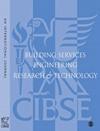Influence of the position of recessed outdoor units and louvre blade angle on the performance of split air conditioners
IF 1.8
4区 工程技术
Q3 CONSTRUCTION & BUILDING TECHNOLOGY
Building Services Engineering Research & Technology
Pub Date : 2021-12-06
DOI:10.1177/01436244211046306
引用次数: 0
Abstract
In residential air conditioning systems, outdoor units are often installed in the recesses of building facades and shaded by louvres; however, different unit installation positions and louvre blade angles affect the thermal environment around the outdoor unit and the energy efficiency ratio (EER) of the air conditioner. In this study, the effects of the outdoor unit installation position and louvre blade angle on the EER when a single outdoor unit was installed in a recess were investigated by experiments on a 1.5 hp air conditioner (rated power of the air conditioner is 3.5 kW), and the influence of the spacing and angle between two outdoor units on the air conditioner EER when two outdoor units were installed in the same recess was explored. The results of the research indicate that when a single outdoor unit is installed in the recess, the EER increases with an increase in the distance between the inlet of the outdoor unit and the wall. To meet the three-level standard of air conditioner EERs, the distance between the inlet and wall needs to be greater than 300 mm. The EER first increased and then decreased slowly with the increase in the distance between the outdoor unit outlet and louvre; thus, the distance between the outlet and louvre should not be less than 300 mm. The EER first increased and then decreased with the increase in the blade angle, and thus, the blade angle should not be greater than 20°. When two outdoor units are installed in the same recess, each installation mode, “horizontal installation” (same height and collinear), “perpendicular installation” (same height and perpendicular), “angle installation” (same height and obtuse angle), and “up and down parallel installation” (different heights and parallel), has an optimum installation distance and angle.嵌入式室外机的位置和百叶窗叶片角度对分体式空调性能的影响
在住宅空调系统中,室外机通常安装在建筑物外墙的凹槽中,并由百叶窗遮蔽;然而,不同的机组安装位置和百叶窗叶片角度会影响室外机周围的热环境和空调的能效比。在本研究中,通过在1.5hp空调(空调额定功率为3.5kW)上的实验,研究了当单个室外机安装在凹槽中时,室外机安装位置和百叶窗叶片角度对EER的影响,探讨了当两台室外机安装在同一凹槽中时,两台室外机组之间的间距和角度对空调能效比的影响。研究结果表明,当单个室外机安装在凹槽中时,EER随着室外机入口与墙壁距离的增加而增加。为了达到空调能效比的三级标准,入口与墙壁之间的距离需要大于300mm。随着室外机出口与百叶窗之间距离的增加,能效比先增大后缓慢减小;因此,出口与百叶窗之间的距离不应小于300mm。随着叶片角度的增加,EER先增大后减小,因此叶片角度不应大于20°。当两台室外机安装在同一凹槽中时,“水平安装”(同高共线)、“垂直安装”(同高垂直)、“角度安装”(相同高度钝角)和“上下平行安装”(不同高度平行)的每种安装方式都有最佳的安装距离和角度。
本文章由计算机程序翻译,如有差异,请以英文原文为准。
求助全文
约1分钟内获得全文
求助全文
来源期刊

Building Services Engineering Research & Technology
工程技术-结构与建筑技术
CiteScore
4.30
自引率
5.90%
发文量
38
审稿时长
>12 weeks
期刊介绍:
Building Services Engineering Research & Technology is one of the foremost, international peer reviewed journals that publishes the highest quality original research relevant to today’s Built Environment. Published in conjunction with CIBSE, this impressive journal reports on the latest research providing you with an invaluable guide to recent developments in the field.
 求助内容:
求助内容: 应助结果提醒方式:
应助结果提醒方式:


